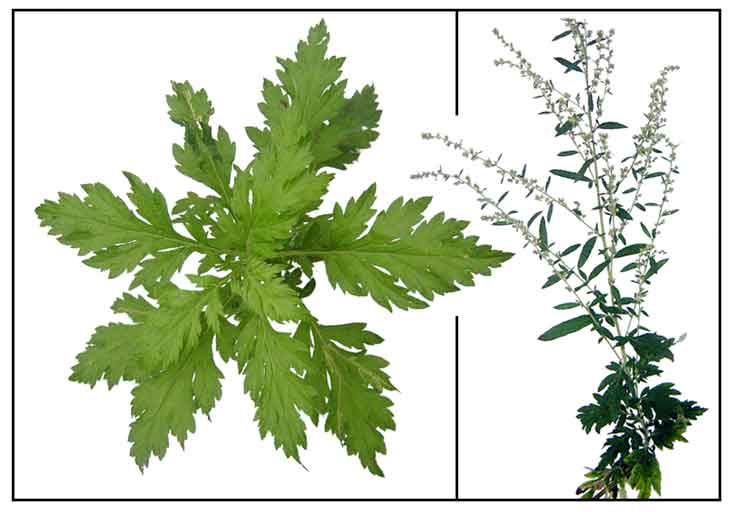| Botany
Erect perennial herb;
hairy, aromatic, often semiwoody, with leafy and branched stems, growing
to a height of 1 meter. Leaves up to 14 centimeters long, lobed, hairy,
gray beneath, with nearly smooth upper surface. Numerous flower heads
are spikelike, ascending, branched inflorescences. Fruit is minute.
Distribution
Widely cultivated in the Philippines, around the houses, gardens and
open places. Propagated by cuttings and layering.
Chemical constituents
and characteristics
Plant yields a volatile oil consisting of cineol, thujone, paraffin
and aldehyde.
Fragrant but bitter to taste.
Emmenagogue
Parts utilized
Leaves and flowers
Uses
Folkloric
- Decoction of fresh leaves and flowering
tops, 50 g in a pint of water, 4-5 glasses daily as expectorant.
- Juice of leaves used as vulnerary, to heal wounds and cuts.
- As emmenagogue: A strong decoction of leaves, 6-7 glasses a day to
induce menstruation; also, for post-partum abdominal cramps.
- Juice of leaves applied to head of young children during convulsions.
- For intestinal deworming, decoction of boiled leaves, followed by
the juice of aloe or other purgative plants.
- Decoction of leaves used for abdominal colic pains.
- Leaf poultice for headache and skin diseases.
- Decoction of dried leaves used for asthma and dyspepsia.
- Juice used externally for scabies, eczema, herpes.
- With ginger: Pounded leaves, mixed with ginger are wrapped in banana
leaves and heated over a fire, and applied to wounds and swollen and
inflammed dermal afflictions.
- Stimulates appetite, young leaves used for anorexia.
Others
- Flowering tops of mugwort used by modern
dyers in the production of green dye.
-Before tobacco, leaves smoked by old people.
- Young and tender leaves used as pot herb.
- Fresh or dried plant repels insects.
Moxa
- Fresh leaves are picked in the spring and
sun-dried, then ground to a fine powder (moxa wool). The wool is kneaded
into cones that are buned on the skin. Sometimes, the Moxa wool is prepared
in combinationn with the powder of other herbals.
• The burning of moxa herb sticks (compressed dried leaves) is
a treatment modality of the acupuncturist. It is placed above the skin,
along meridians or specific acupuncture points, mean to restore good
health, energy balancing, release of Qi - a process called Moxibustion.
• The moxibustion of mugwort has been used in correcting breech
presentation of fetuses into cephalic orientation. Also used to cause
abortion.
Studies
• Phytochemicals: Study of dichlormethane extract of dried-leaves of Av yielded a new sesquiterpene 1, caryophyllene oxide, phytyl fatty esters, squalene, stigmasterol and sitosterol.
• Estrogenic Flavonoids from Artemisia
vulgaris L. : A study isolated twenty known flavonoids,
the most abundant were eriodictyol and luteolin. Two flavonoids, eriodictyol
and apigenin, induced the transcription of the estrogen receptor gene
in transgenic yeast.
• Major dicaffeoylquinic acids from Artemisia
vulgaris
• Hepatoprotective: Hepatoprotective activity of aqueous-methanol
extract of Artemisia vulgaris: Pre-treatment of mice reduced
the toxin-induced rise in ALT and AST in induced-hepatitis. The study
scientifically validates the traditional use of A. vulgaris for various
liver disorders.
• Anti-inflammatory: In vivo
microvascular actions of Artemisia vulgaris L. in a model of ischemia-reperfusion
injury in the rat intestinal mesentery: Study showed
the extracts significantly reduced leukocyte adherence and transendothelial
leakage while improving flow in the ischemia-reperfused organ. The extract
contained yomogin, previously shown to inhibit iNOS activity, and may explain the anti-inflammatory porperty of
the plant.
• Moxa Burning–Health Hazard? - UK tested the potential toxicity of smoke produced by the buring of Moxa in traditional Chinese medicine. Sidestream smoke from cigar-shaped "sticks" or "rolls" of Moxa was tested showed levels of only two volatiles equivalent or greater than the safe exposure levels, as well as carbon monoxide levels. Study gives no immediate concerns from continued use of moxa as a therapeutic modality. However, it suggests further testing for ventilation, cleansing of room environ and use of moxa on broken skin.
• Anti-Trichinellosis: Trichinellosis can cause diarrhea, fever, periorbital edema and myositis in humans. This study on the methanol extracts of aerial parts of Av showed reduction of larval rate with significantly reduced antibody response during the enteral and parenteral phases. Results suggest Av can be an alternative drug against trichinellosis.
• Anti-Hypertensive: Study suggests that the aqueous and chloroform extracts of leaves of Av have anti-hypertensive actions with not significant effecfts on cardiovascular hemodynamics.
• Antioxidant: Study of extract of Av yielded flavonoidal and flavonol contents and exhibited nitric oxide scavenging activity, significant increases in glutathione level, superoxide dismutase activity and serum ascorbic acid levels. Results indicate Av is a potential source of natural antioxidants.
• Anticonvulsant: In a study of the aqueous extracts of leaves and stems of seven medicinal plants on Picrotoxin-induced seizures in mice, Artemisia vulgaris was one of four extracts to delay the onset of seizures and decrease the mortality rate.
Caution
Pregnancy:
Should not be used by pregnant women.
Availability
Wild-crafted.
|



![]()

